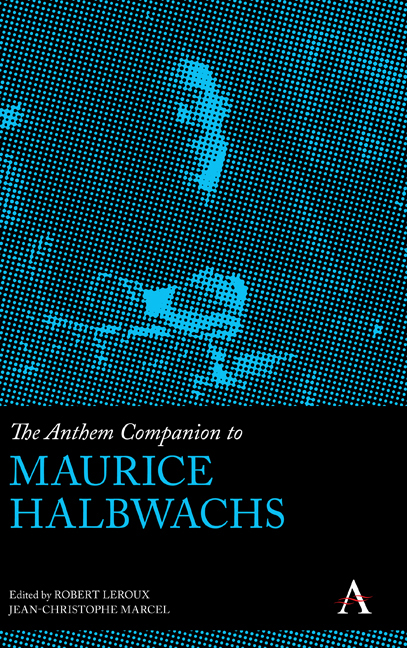Book contents
- Frontmatter
- Contents
- Introduction
- Chapter 1 A Theorist of Collective Memory
- Chapter 2 Halbwachs and the Durkheimian Perspective on History
- Chapter 3 Maurice Halbwachs, Sociologist of Memory: His Reception in Italy and the Development of the Sociology of Memory
- Chapter 4 Population as the Body of Society
- Chapter 5 Urban Morphology and Social Morphology: Marcel Roncayolo and the Work of Maurice Halbwachs
- Chapter 6 Halbwachs’s Leibniz and Halbwachs’s Sociology
- Chapter 7 Halbwachs on Quetelet and the Use of Statistics in Sociology
- Chapter 8 Maurice Halbwachs and the Sociology of Consumption and Social Classes
- Chapter 9 From Criticism of Moral to the Probalistic Test
- Chapter 10 The Age Criterion: Between Sociology and Biology
- Chapter 11 Speculation: Order or Disorder?
- List of Contributors
- Index
Chapter 10 - The Age Criterion: Between Sociology and Biology
Published online by Cambridge University Press: 23 February 2022
- Frontmatter
- Contents
- Introduction
- Chapter 1 A Theorist of Collective Memory
- Chapter 2 Halbwachs and the Durkheimian Perspective on History
- Chapter 3 Maurice Halbwachs, Sociologist of Memory: His Reception in Italy and the Development of the Sociology of Memory
- Chapter 4 Population as the Body of Society
- Chapter 5 Urban Morphology and Social Morphology: Marcel Roncayolo and the Work of Maurice Halbwachs
- Chapter 6 Halbwachs’s Leibniz and Halbwachs’s Sociology
- Chapter 7 Halbwachs on Quetelet and the Use of Statistics in Sociology
- Chapter 8 Maurice Halbwachs and the Sociology of Consumption and Social Classes
- Chapter 9 From Criticism of Moral to the Probalistic Test
- Chapter 10 The Age Criterion: Between Sociology and Biology
- Chapter 11 Speculation: Order or Disorder?
- List of Contributors
- Index
Summary
Exploring the relationship between biology and sociology led the founders of sociology and their followers to focus on the criteria of sex and age. Maurice Halbwachs approached them both in his works of social morphology and of collective memory, constituting two variations of the objectivization of social times and social spaces. His approach combined the methods learned from his two masters. That of Henri Bergson when he was in philosophy class at the Lycée Henri IV in Paris, and that of sociology by Émile Durkheim, which constitutes a second later set of references. Henri Bergson's method consisted in rigorously analyzing the texts by focusing on their coherence, and not in going from one author to another, as did most of the philosophers of his time. Halbwachs will learn from this lesson. In Les Règles de la méthode sociologique, Durkheim explained Halbwachs the means of a construction and an assessment in the manner of Claude Bernard's experimental approach. His method is therefore hybrid, and the tensions in the transmission of philosophical styles over the course of the twentieth century have blurred what for Halbwachs was after all quite simple: his two masters had taught him to practice two types of exercises of philosophical rigor. The differences time will exacerbate between them were for the student many places where questions arose and where they required a tenacious investigation (Jaisson, 2008).
In his text Le Point de vue du nombre – called “comparative demography of the human species” by the historian Lucien Febvre, agent of volume VII of L’Encyclopédie Française – Halbwachs discusses to which extent age, admittedly organic, can also be social through representation systems and institutions. If we find there the material and organic basis that a Durkheimian could assign to social phenomena by implicitly adopting the Comtian classification of sciences, Halbwachs, however, undermines the presuppositions of positive philosophy.
Nowadays, the variables of sex and age are undoubtedly among the most studied by demographers, and their variations the most commented in the social sciences. The age and sex distributions are, in fact, one of the clearest indicators of the social structures of reproduction, which can be grasped at the global level of populations, but also at finer levels of scale, such as, for example, a professional group.
- Type
- Chapter
- Information
- The Anthem Companion to Maurice Halbwachs , pp. 145 - 154Publisher: Anthem PressPrint publication year: 2021



